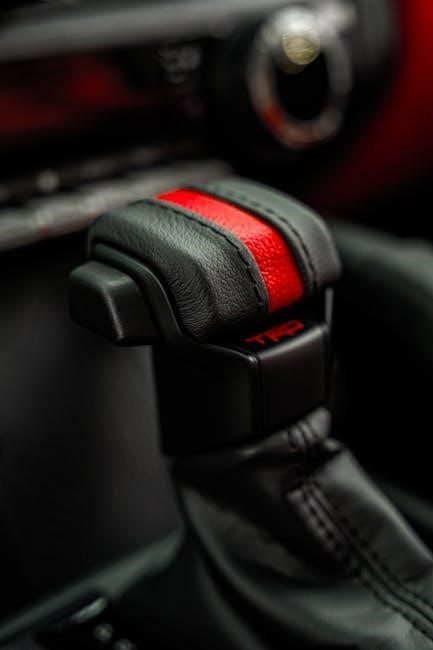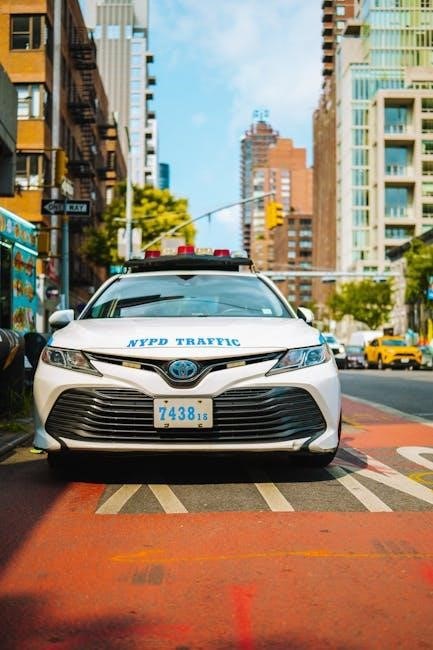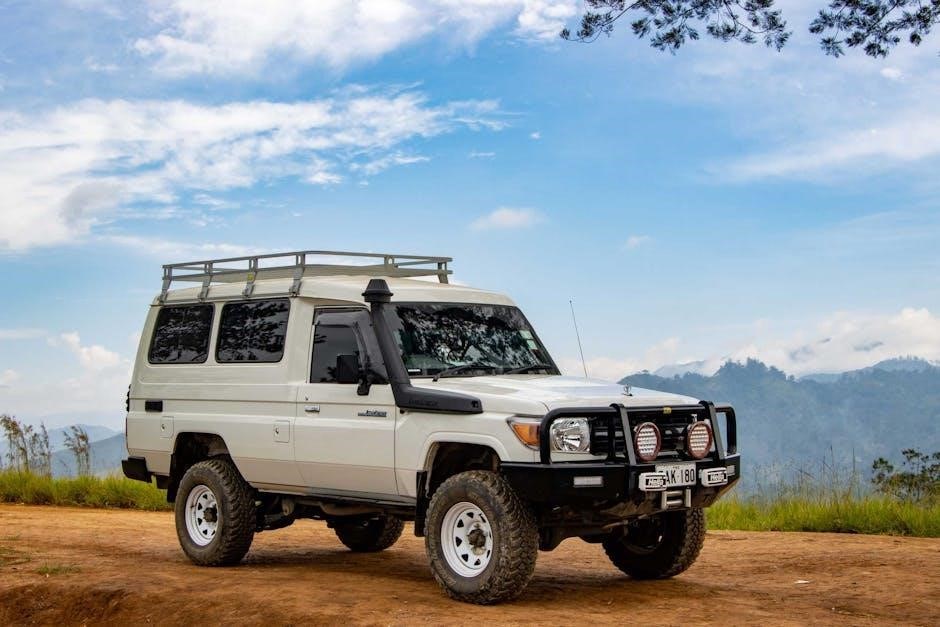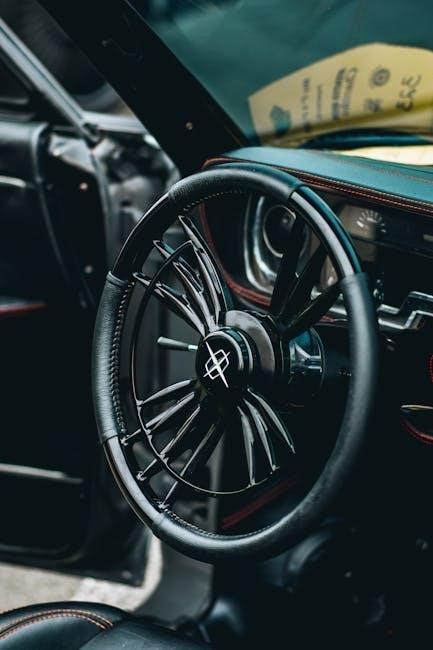The 2017 Toyota Highlander Manual provides essential guidance for optimizing vehicle performance, safety, and maintenance. It covers features like Toyota Safety Sense, automatic transmission, and interior configurations, ensuring a smooth driving experience.
Overview of the Manual
The 2017 Toyota Highlander Manual is a comprehensive guide designed to help owners understand and utilize their vehicle effectively. It is structured to be user-friendly, covering key aspects such as safety features, driving tips, and maintenance schedules. The manual serves as a central reference point, detailing everything from the operation of advanced technology systems to routine care practices. By following the manual, drivers can maximize their vehicle’s performance, safety, and longevity, ensuring a seamless and enjoyable driving experience. It is an essential resource for both new and experienced Highlander owners.
Importance of Reading the Manual
Reading the 2017 Toyota Highlander Manual is crucial for understanding safety features, proper vehicle operation, and maintenance. It provides insights into Toyota Safety Sense, instrument cluster readings, and troubleshooting tips. The manual ensures optimal performance, enhances safety, and helps prevent potential issues. By familiarizing yourself with its contents, you can navigate features like the Entune Audio System and automatic transmission efficiently. Regular maintenance schedules and fluid checks are also detailed, promoting longevity and reliability. Stay informed about updates and guidelines to maximize your driving experience and ensure compliance with manufacturer recommendations.

Safety Features and Precautions
The 2017 Toyota Highlander Manual emphasizes advanced safety features like Toyota Safety Sense, Pre-Collision System, and Lane Departure Alert to prevent accidents and enhance driving safety.
Toyota Safety Sense Overview
The 2017 Toyota Highlander features Toyota Safety Sense, a suite of advanced safety technologies designed to enhance driver confidence and reduce accident risks. This system includes Pre-Collision System (PCS), Lane Departure Alert (LDA), and adaptive cruise control. These features work seamlessly to monitor the vehicle’s surroundings, providing alerts or interventions when necessary. By integrating cutting-edge sensors and cameras, Toyota Safety Sense helps drivers stay aware of potential hazards, ensuring a safer and more controlled driving experience. It exemplifies Toyota’s commitment to innovation and passenger protection.

Pre-Collision System (PCS)
The Pre-Collision System (PCS) in the 2017 Toyota Highlander is a safety feature designed to help prevent or mitigate frontal collisions. Using a combination of cameras and sensors, PCS detects potential collisions and alerts the driver. If a collision is imminent and the driver doesn’t react, the system can automatically apply the brakes. PCS is active at speeds above a certain threshold and works in conjunction with other safety technologies. However, it is not a substitute for attentive driving. Always refer to the manual for detailed operation and limitations of the system.
Lane Departure Alert (LDA)
The Lane Departure Alert (LDA) system in the 2017 Toyota Highlander enhances driving safety by monitoring lane markings on the road. Using a camera, it detects when the vehicle drifts out of its lane without a turn signal. The system alerts the driver through auditory, visual, or steering wheel vibrations. Drivers can customize sensitivity settings to suit their preference. LDA is designed to function at speeds above 32 mph and may deactivate in heavy traffic or poor visibility. It does not actively steer the vehicle, ensuring the driver remains in control. Regular calibration is recommended for optimal performance.

Driving Information
The 2017 Toyota Highlander Manual offers insights into operating the vehicle, including instrument cluster functions, warning light explanations, and tips for smooth automatic transmission operation.
Instrument Cluster Explanation
The instrument cluster in the 2017 Toyota Highlander displays vital vehicle information, including speed, odometer, trip meters, fuel level, and engine temperature. Warning lights indicate system status or potential issues, such as low fuel, open doors, or malfunctioning features. The manual explains each indicator, ensuring drivers understand their meanings and respond appropriately. This section helps owners monitor their vehicle’s performance and maintain safety while driving. Understanding the instrument cluster is crucial for optimal vehicle operation and troubleshooting. Refer to this guide for detailed explanations of all dashboard symbols and their functions.
Understanding Warning Lights
The 2017 Toyota Highlander features a comprehensive warning light system to alert drivers of potential issues. These lights, located on the instrument cluster, indicate everything from low tire pressure to more serious mechanical concerns. Colors like red, yellow, or blue signify the severity of the issue. For instance, a red exclamation mark in a circle may indicate a tire pressure warning, while an engine icon could signal a problem under the hood. Always consult the manual for detailed explanations of each light to ensure proper vehicle maintenance and safety.
Operating the Automatic Transmission
The 2017 Toyota Highlander features a smooth-shifting automatic transmission designed for seamless driving. To operate, shift into P (park), R (reverse), N (neutral), or D (drive) using the gear selector. For manual control, use the sequential shift mode or paddle shifters. The transmission adapts to driving conditions, ensuring optimal performance; Always check the instrument cluster for gear indicators. Use the brake pedal when shifting to P or R. The system integrates with Toyota Safety Sense for enhanced control, providing a safe and efficient driving experience.

Maintenance and Care
Regular maintenance ensures optimal performance. Follow the recommended schedule for oil changes, tire rotations, and fluid checks. Proper care extends the vehicle’s lifespan and reliability.
Recommended Maintenance Schedule
The 2017 Toyota Highlander Manual outlines a detailed maintenance schedule to ensure optimal performance and longevity. Routine services include oil changes every 5,000 to 7,500 miles, tire rotations every 5,000 miles, and fluid checks during each visit. Additionally, the manual recommends replacing the air filter every 15,000 miles and the spark plugs at 30,000 miles. Brake inspections and battery checks should be performed annually or as specified. Following the schedule helps prevent potential issues, ensuring your Highlander runs efficiently and safely for years to come.
Fluid Check Guidelines
Regular fluid checks are crucial for maintaining your 2017 Toyota Highlander. Ensure engine oil, coolant, transmission, and brake fluids are at recommended levels. Locate the dipsticks or reservoirs as outlined in the manual. Check levels when the engine is cold for accuracy. Topping off fluids should be done carefully to avoid overfilling. Refer to the manual for specific guidelines on fluid types and capacities. Proper fluid maintenance ensures optimal performance, prevents damage, and extends the vehicle’s lifespan. Always use Toyota-approved fluids for reliability and compatibility.

Tire Pressure and Rotation
Proper tire pressure and rotation are crucial for the 2017 Toyota Highlander’s performance and longevity. The manual recommends checking tire pressure monthly and before long trips, using the pressure specified in the owner’s manual or tire information placard. Under-inflation can reduce fuel efficiency and increase wear. Tire rotation should occur every 5,000 to 8,000 miles to ensure even tread wear and extend tire life. Follow the recommended rearward cross pattern for rotation, and always check wheel alignment during service to maintain optimal handling and safety.

Interior Features
The 2017 Toyota Highlander offers versatile seating configurations, ample cargo space, and advanced climate control systems. Its interior design emphasizes comfort and convenience for all passengers.
Seats and Cargo Space Configuration
The 2017 Toyota Highlander offers versatile seating and cargo options, accommodating up to 8 passengers with its standard third-row seating. The second-row seats can be configured with either bench seats or optional captain’s chairs, while the third-row seats fold flat to maximize cargo space. For added convenience, the rear seats feature a 60/40 split-fold design, allowing for customizable storage solutions. The vehicle also includes ample storage compartments and cup holders throughout, ensuring comfort and practicality for both passengers and cargo.
Climate Control and Air Conditioning
The 2017 Toyota Highlander features a dual-zone automatic climate control system, allowing driver and passenger to set individual temperatures. The system includes advanced air quality sensors to monitor and filter pollutants. Rear-seat passengers benefit from dedicated climate controls, ensuring comfort throughout the cabin. The manual provides detailed instructions for customizing settings, using Eco mode to optimize energy efficiency, and troubleshooting common issues. Proper usage of the climate control system ensures a comfortable driving experience year-round, as outlined in the 2017 Toyota Highlander Manual.
Interior Comfort and Convenience Features

The 2017 Toyota Highlander offers a spacious and versatile interior designed for comfort and convenience. It features premium seating materials, heated and ventilated front seats, and a third-row seat for added versatility. The cargo area provides ample storage space, with foldable rear seats for maximum flexibility. Additionally, the Highlander includes advanced convenience features like a moonroof, power liftgate, and keyless entry. The Entune infotainment system integrates seamlessly with smartphones, offering a user-friendly interface for navigation, music, and hands-free calls, ensuring a comfortable and enjoyable driving experience for all passengers.

Technology and Entertainment
The 2017 Toyota Highlander features the Entune Audio System, offering navigation, Bluetooth, and smartphone integration. It includes voice command controls and a touch-screen interface for seamless connectivity and entertainment.
Entune Audio System Overview
The Entune Audio System in the 2017 Toyota Highlander offers a seamless infotainment experience. It features a touchscreen display, voice recognition, Bluetooth connectivity, and smartphone integration via USB and AUX inputs. The system supports AM/FM radio, CD playback, and optional navigation. With customizable settings and high-quality sound, it enhances driving comfort. Drivers can access apps, stream music, and manage calls hands-free, ensuring a connected and enjoyable journey. The system is user-friendly, designed to integrate modern tech with intuitive controls for a superior in-car entertainment experience.
Navigation System Operation
The 2017 Toyota Highlander navigation system provides turn-by-turn directions, voice commands, and real-time traffic updates. Access the system via the touchscreen or steering wheel controls. Enter destinations using voice or manual input. The system also supports saved favorite locations and recent searches. For optimal use, ensure the vehicle is in a well-ventilated area and the GPS signal is strong. Regular updates may be required for accurate mapping. Refer to the manual for troubleshooting tips, such as resetting the system or updating maps. This feature enhances convenience and ensures stress-free navigation during trips.
Bluetooth and Smartphone Integration
The 2017 Toyota Highlander supports seamless Bluetooth and smartphone integration, enabling hands-free calls, music streaming, and voice command functionality. Pairing your device is straightforward: search for the vehicle’s Bluetooth signal, enter the PIN, and connect. The Entune Audio System allows syncing contacts and audio playlists, enhancing your driving experience. For added convenience, Siri EyesFree compatibility is available for iPhone users, enabling voice commands without distractions. This feature ensures safe and intuitive connectivity on the go.

Troubleshooting and Repair
The manual addresses common issues, providing solutions and DIY repair tips. It also guides on when professional assistance is necessary, ensuring your Highlander runs smoothly and safely.
Common Issues and Solutions
Common issues with the 2017 Toyota Highlander include warning lights illuminating, transmission hesitation, and infotainment system glitches. For warning lights, consult the manual or dashboard symbols guide to identify the cause. Transmission issues may require software updates or fluid checks. Infotainment problems can often be resolved by restarting the system or updating software. Regular maintenance, such as oil changes and tire rotations, can prevent many of these issues. If problems persist, refer to the troubleshooting section or consult a professional technician for assistance.
DIY Repair Tips
For minor repairs, the 2017 Toyota Highlander Manual encourages using genuine parts and following OEM guidelines. Start with simple tasks like oil changes or tire rotations. Always consult the manual before beginning any repair to ensure safety and accuracy. DIY projects like replacing air filters or wiper blades can save costs. Use the manual’s diagrams and step-by-step instructions for clarity. Avoid attempting complex repairs without proper tools or expertise, as this could damage your vehicle. For advanced issues, consider consulting a professional mechanic to maintain your Highlander’s performance and longevity.
When to Consult a Professional
While the 2017 Toyota Highlander Manual provides comprehensive guidance, certain issues require professional expertise. If you encounter complex mechanical or electrical problems, consult a certified Toyota technician. This includes advanced diagnostics, safety system repairs, or issues requiring specialized tools; Additionally, for persistent or unfamiliar problems, seeking professional help ensures safety and prevents further damage. Always prioritize professional assistance when dealing with critical systems like the Pre-Collision System or Lane Departure Alert to maintain vehicle reliability and passenger safety.
The 2017 Toyota Highlander Manual serves as a comprehensive guide for owners, ensuring optimal performance, safety, and longevity. Regular consultation is key for a hassle-free driving experience, while additional resources provide deeper insights for advanced users.
Final Tips for Optimal Use
For the best experience with your 2017 Toyota Highlander, ensure regular maintenance checks, such as fluid levels and tire pressure, to maintain performance. Familiarize yourself with the Entune Audio System and Bluetooth integration for seamless connectivity. Always reference the manual for specific guidelines on safety features like Toyota Safety Sense. Understanding the instrument cluster and warning lights can prevent potential issues. Lastly, stay informed about updates and troubleshooting tips through official resources to keep your Highlander running smoothly and safely.
Additional Resources for Further Learning
For deeper understanding, explore the official Toyota Owners Portal, offering downloadable PDF manuals and guides. Visit Toyota’s website for detailed instructions on Safety Sense, Entune Audio, and maintenance schedules. Websites like ManualsLib and ManualsOnline provide free access to the 2017 Highlander manual. Additionally, Toyota forums and YouTube tutorials offer practical tips and visual demonstrations for troubleshooting and DIY repairs. These resources complement the manual, ensuring comprehensive knowledge of your vehicle’s features and optimal performance.